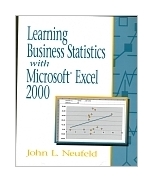Learning Business Statistics
with Microsoft Excel 2000, 1/e
John Neufeld , University of
North Carolina, Greensboro
Published August 2000 by Prentice Hall Business Publishing
Copyright 2001, 450 pp.
Paper ISBN 0-13-030878-1
Summary
This great supplemental text
is appropriate for business statistics students at both the undergraduate and MBA level
who are not experts in the use of Excel.
This text is designed to
reflect the important changes in the teaching of statistics brought about by the use of
computers. It takes advantage of the ability of computers to help students understand
statistical methods. It uses a straightforward, step-by-step approach, and uses the
computer both as a tool for solving statistical problems and as pedagogical device to help
students understand statistical concepts.
Features
- NEW-Excel
usage has been simplified-Less emphasis on formatting. More emphasis on helping students
get the "big picture."
- Excel
is used to help students understand statistical concepts.
- NEW-Excel
is used more as a scratch pad-The approach has moved from creating worksheets which
automatically solve problems to using Excel as a scratch pad for each problem that arises.
- Excel
is an aid to student understanding, not a "black box" which gives the correct answer
even if the student doesn't understand why.
- NEW-All
screen captures updated to Excel 2000 and all the material has been tested on Excel 2000.
- Provides
students with the most current software version in the marketplace.
- Step-by-step
instructions-Detailed instructions are given as each new topic is introduced. As
students become more familiar with the topics less coaching is provided.
- Provides
students with detailed instructions while they are learning to use Excel.
- Good
for novice Excel users.
- Computer
demonstrations reinforce student understanding-Students are directed to use Excel's
random number generation tool and the book's exclusive multiple random sample generation
tool to gain insight into probability distributions and inferential statistics. For
example:
- Students
see directly the relationship between the expected value and standard deviation of a
random variable and the mean and variance of a large set of actualized values. The
difficult concepts of Type I and Type II error and the relationship between test power,
sample size, and significance level are explored by the student using Excel to perform
1,000 tests of a single hypothesis on each of three different populations. Innovative use
of Excel graphics enables students to directly manipulate probability distributions and
easily visualize relationships.
- Practical
skills developed-Excel software is widely used in both the academic and professional
market.
- Students
learn how to use Excel to do statistics early in their careers and will be able to
directly apply the data analysis techniques they learned on the job. Business students are
likely to use Excel in other courses. Many will come to statistics with some knowledge of
Excel and will appreciate the value of improving their skills for use in other courses.
- Appropriate
for Macintosh users (on Excel 98 and expected next version of Mac Excel) as well as PC
users.
- Students
and faculty who use Macs, or wish to switch between Macs and PCs, will have no difficulty.
The book's data are available in both PC and Mac formats.
Table of Contents
1. Introduction to Excel.
2. Descriptive Statistics.
3. Discrete Random Variables and Probability Distributions.
4. The Binomial Distributions.
5. The Normal Distribution.
6. The Sampling Distribution of the Mean.
7. Confidence Intervals on a Population Mean.
8. Understanding Hypothesis Testing.
9. Hypothesis Testing of a Population Mean.
10. Inferences on a Population Proportion.
11. Inferences on a Population Variance.
12. Inferences on Two Population Means.
13. Analysis of Variance.
14. Simple Linear Regression.
15. Multiple Regression.
Appendix A-Obtaining the Data.
Appendix B-Setting Up the Analysis Tools.
Appendix c-Installing the Learning Business Statistics Add-In.
Appendix D-Statistical Functions and Analysis Tools.
Appendix E-Answers to Selected Exercises.
Appendix F-Storing a Large File on a Diskette.
Księgarnia nie działa. Nie odpowiadamy na pytania i nie realizujemy zamówien. Do odwolania !.


